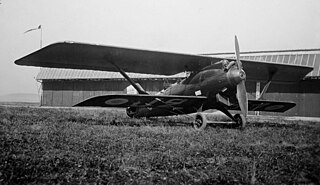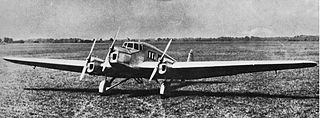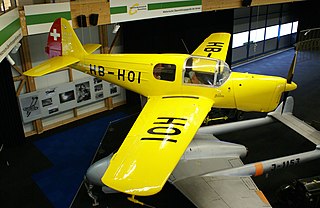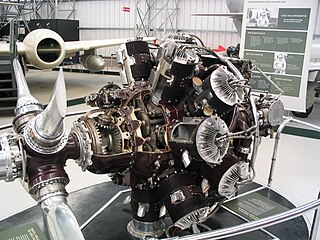
The Dassault MD 315 Flamant is a French light twin-engined transport airplane built shortly after World War II by Dassault Aviation for the French Air Force.

The Breguet 19 was a light bomber and reconnaissance aircraft, also used for long-distance flights, designed by the French Breguet company and produced from 1924.

The Breguet 761/763/765 are a family of 1940s and 1950s French double-deck transport aircraft produced by Breguet Aviation. The aircraft were normally called the Deux-Ponts (Double-Decker) but it was not an official name.

The Fouga CM.10 was an assault glider designed for the French Army shortly after World War II, capable of carrying 35 troops, later converted as a powered transport.

The Breguet 280T was a French biplane airliner of the late 1920s, created by the manufacturer as a means of finding a civil market for their 19 warplane, as they had once tried before with the 26T.

The Breguet 390T, 392T and 393T were a family of French propeller-driven airliners of the mid-1930s.

The Breguet 27 was a 1930s French biplane military reconnaissance aircraft, built for the Armée de l'Air and for export to Venezuela and China.

The Farman F.430 was a 1930s French light transport designed and built by the Farman Aviation Works. Two variants with different engines were known as the F.431 and F.432.

The Fairchild 22 Model C7 was an American two-seat touring or training monoplane designed and built by the Kreider-Reisner division of the Fairchild Aircraft Corporation at Hagerstown, Maryland.

The Fiat G.2 was an Italian three-engine six-passenger monoplane transport aircraft designed by Giuseppe Gabrielli and built by Fiat.

The Nord 1200 Norécrin is a French two or three-seat cabin monoplane designed and built by Nord Aviation.

The SNCAC NC.211 Cormoran was a large four-engined military transport aircraft for passengers and cargo designed and built by SNCAC from 1945.

The Morane-Saulnier Vanneau is a two-seat basic trainer built in France by Morane-Saulnier and ordered by the French Air Force.

The Potez 36 was a French two-seat touring or sport monoplane designed and built by Potez. The Potez 36 was a high-wing braced monoplane with a conventional landing gear. It had an enclosed cabin with side-by-side seating for a pilot and passenger. The design had some unusual features like folding wings to make it easier to store or to tow behind a motor car. Some of the aircraft had Potez-designed leading-edge slats. The aircraft was popular with both French private owners and flying clubs with a small number being used by the French Air Force during the 1930s as liaison aircraft.

The Sud-Ouest Corse was a French mail and passenger transport aircraft, built by SNCASO.
The Breguet 790 Nautilus was a prototype French three-seat coastal patrol flying-boat designed and built by Breguet Aviation to meet a requirement from the French navy.
The Nord 2100 Norazur was a 1940s French civil transport monoplane designed and built at Courbevoie near Paris by SNCAN.
The Breguet 500 Colmar was a 1940s French airliner designed by Breguet Aviation. Two prototypes were built during the Second World War but only one survived to fly in 1945. The prototype went on to operate as a VIP transport with the French Air Force but no others were built.
The SNCASE SE-1210 was an experimental French flying-boat designed and built by SNCASE as a flying scale model of the proposed SE-1200 transatlantic flying boat.
The Morane-Saulnier MS-700 Pétrel was a French four-seat cabin-monoplane designed and built by Morane-Saulnier, only three prototypes were built.




















